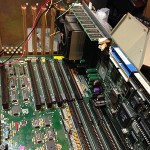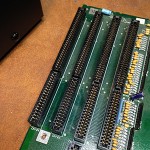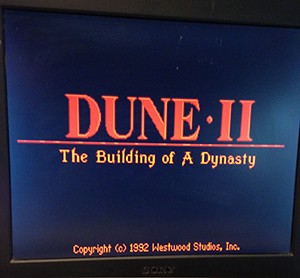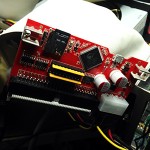Hardware Changes and Adjustments (Part 1 of 3)
- OS3.9 on DH0: and OS1.3 on DH1: — Easy booting to each OS.
- Replaced the AMIGANET 1.1 / Hydra with and XSurf100 using AmiTCP. Networking is going great in OS3.9
- Combined with XSurf100, is the RapidRoad USB addon card. I’ve mounted a variety of devices — setup was a little weird but once it was working, it worked well. Was impressed by the device support.
- Got 2 more GVP 4MB ram modules, Chip: 1MB, Extended: 16Mb on the 030
- With the 030 Processor Upgrades to 50MHrz and an MMU, FASTROM Enabled.
I had two Primary machines in Artschool, one was Yuri and the other was a Pentium 133 in the school lab. Years later, after working at the same school and passing the baton on to another — someone showed up to a house party with my Old computer in tow. The machine had been in storage and I had a disk backup of the machine. The IDE drive was cooked and there was some damage to the machine’s PSU. It was a gift I wanted to get going.
In order to get the rest of the changes completed, I needed to pull out the motherboard from the case.
 I found a Goldfinger card on Ebay, which if you want to know more about them: Here and Here. The card is a PEAK650VLB, which is basically everything you need for a computer (minus a soundcard) on one ISA card. It’s like the bridgeboard for the Amiga, but a million times better. It has a 1ghrz Pentium 4, with 64 megs of ram, EIDE controllers, USB and two NIC’s (100mb). It’s a 16bit ISA Card, with a PCI edge near the front of the card. So it can be placed in either BUS system type.
I found a Goldfinger card on Ebay, which if you want to know more about them: Here and Here. The card is a PEAK650VLB, which is basically everything you need for a computer (minus a soundcard) on one ISA card. It’s like the bridgeboard for the Amiga, but a million times better. It has a 1ghrz Pentium 4, with 64 megs of ram, EIDE controllers, USB and two NIC’s (100mb). It’s a 16bit ISA Card, with a PCI edge near the front of the card. So it can be placed in either BUS system type.
The Amiga has ISA slots — 2 8bit and 2 16bit, which are dumb slots. And the PEAK650VLB is a card that takes over the ISA BUS, so I could add a few ISA cards into the mix. Last time I checked, the only 8bit ISA cards I had were a modem and PS2 port. Everything else (including my P133) was 16bit.
The Amiga 2000’s 8bit ISA slots can be upgraded to 16bit, if you solder on the extra connector. The PEAK650VLB is a monster full sized card (the heat sinks add to the girth), but because of the PCI connector it will not fit in the stock 16bit card slots.. only the outer slots (8bit) have the space to take the card. So it looks like some soldering is needed.
*I desoldered two of the 16bit ISA card slots from my old P133*.
 I did not know what I was thinking when I did that. It was such a brutal exercise initially. A solder sucker and iron took forever to get the first slot, which I will never get that time back again. Even after the solder comes off, trying to find the pins that had a minuscule amount of solder on them (preventing the slot from coming out) was impossible. Solder wick was faster on the second attempt, but still the connectors were impossible to pull out from the sheer amount of pins.
I did not know what I was thinking when I did that. It was such a brutal exercise initially. A solder sucker and iron took forever to get the first slot, which I will never get that time back again. Even after the solder comes off, trying to find the pins that had a minuscule amount of solder on them (preventing the slot from coming out) was impossible. Solder wick was faster on the second attempt, but still the connectors were impossible to pull out from the sheer amount of pins.
If you ever have to pull out a lot of stuff from a board, something like a rework station is needed. Sparkfun has one: 303D. There are moments in life where you think: Where was this 10 years ago? The third slot and the remaining two came out in a fraction of the time. I wish I had a 303D from the beginning. Awesome! Chopped off the 16bit part of the slot and solder to the Amiga.
So with the two slot’s upgraded, we get the next round of upgrades:
- PEAK650VLB with Pentium4 1Ghrz, 64MB ram.
- AudioTrix Pro Sound card (ISA) with Soundblaster Emulation
- Compactflash Drive to EIDE Converter. 4GB storage on CF.
- Custom made bracket for the CF Card, to load out the back of the Amiga
- DOS 6.22, Windows 98 and Debian Linux installed.
 DOS 6.22, was a pain to get working with a more modern system. PNP and BIOS configs to get the sound card to work in DOS was something I pleasantly forgot.. but after a little brain massaging it worked. I installed DOOM3D and DUNE2, both of which I still have the original install disks. I copied over my original school/work backups from an ISO I made years ago. FRACTINT still looks great 🙂
DOS 6.22, was a pain to get working with a more modern system. PNP and BIOS configs to get the sound card to work in DOS was something I pleasantly forgot.. but after a little brain massaging it worked. I installed DOOM3D and DUNE2, both of which I still have the original install disks. I copied over my original school/work backups from an ISO I made years ago. FRACTINT still looks great 🙂
I still need to make a backplane for the USB and Serial Ports for the PC side.
 The last of the upgrades is SCSI2SD. This device basically is a hard disk replacement for computers with SCSI-2 interfaces. Insert an SD card, connect the device to a USB computer and configure how many SCSI devices and their sizes. Connect the device to the computer’s SCSI chain, boot and partition. It was pretty easy.
The last of the upgrades is SCSI2SD. This device basically is a hard disk replacement for computers with SCSI-2 interfaces. Insert an SD card, connect the device to a USB computer and configure how many SCSI devices and their sizes. Connect the device to the computer’s SCSI chain, boot and partition. It was pretty easy.
I did some speed tests before and after. I was a little sad with the results:
Seagate HAWK: 2.1MB/sec
SCSI2SD: 1.6MB/sec
Maybe a different card choice or configuration might improve the stats. But the real amazing thing about this is that you can take the SD card out, back it up as an image and put it back. Multiple cards, multiple setups. I’m going to try and workout why the transfer loss, but at the moment I am happy with what I couldn’t do that easily before the change.

Nice to see someone else is trying the A2000 + PC SBC route! I myself did the same, but I had way too many problems with sound card not working as intended (only getting mono out of stereo card, AWE64 Gold midi synth not working etc.). Some advice I got suggested that the ISA lanes on A2000 are too noisy for 16bit sound blaster. Might be that or just me not having succeeded in soldering the 16bit connectors — difficult to say.
I didn’t have to go through the worst part though — I ordered the connectors directly from Ebay. 🙂
That looked so cool that I got umm, several, for myself. I also have the hot air station as well as an IR rework station. But I will probably go the eBay route for the connectors as well.
As for the SCSI2SD, could you post your setup for your 2000 please? I can’t seem to get mine to behave. As for the Seagate Hawks, I have two here that you can have. I couldn’t get the darn things working. I finally gave up and used Quantums.
Most of the time it has to do with how things are terminated and the controller in use. SCSI is such a temperamental system if you don’t follow the basics correctly — which everyone breaks. I found out that one my CD-ROM’s was not happy being in the chain.
The best thing to do is ensure that the scsi chain itself is working properly. Often some chains work barely and are improperly setup, the moment a change is made suddenly it goes to hell. I’ll follow up with you via email to see how things are going.